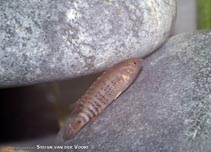http://www.fishbase.org/Summary/speciesSummary.php?genusname=Badis&speciesname=pyema ---> http://192.134.151.83/Summary/speciesSummary.php?genusname=Badis&speciesname=pyema
http://192.134.151.83/Summary/speciesSummary.php?genusname=Badis&speciesname=pyema ---> https://fishbase.mnhn.fr/Summary/speciesSummary.php?genusname=Badis&speciesname=pyema
https://fishbase.mnhn.fr/Summary/speciesSummary.php?genusname=Badis&speciesname=pyema ---> https://fishbase.mnhn.fr/summary/Badis-pyema.html
Badis pyema

You can
sponsor
this page
Common name (e.g. trout)
Genus + Species (e.g. Gadus morhua)
-

-
About this page
-
Languages
-
User feedbacks
-
Citation
-
Uploads
-
Related species
-


 Upload your
photos
and
videos
Upload your
photos
and
videos
Pictures
|
Google image
 Badis pyema
Badis pyema
Male picture by
van der Voort, S.
Teleostei (teleosts) >
Anabantiformes
(Gouramies, snakeheads) >
Badidae
(Chameleonfishes)
Etymology:
Badis:
'badis' is presumably a Bengali local name, possibly derived from 'bhedo' or 'bheda', but it lacks a proper reference. Probably incorrect etymology (J. Müller, pers. comm., April 2021, after information from native speakers)
;
pyema:
Specific name from the local name 'Nga-pyema' recorded at Putao; Noun in apposition.
.
More on authors:
Kullander
&
Britz
.
Environment: milieu / climate zone / depth range / distribution range
Ecology
Freshwater; benthopelagic. Tropical
Asia: Myanmar.
Size / Weight / Age
Maturity: L
m
?
range ? - ? cm
Max length : 4.1 cm SL male/unsexed; (Ref.
46238
)
Short description
Morphology
|
Morphometrics
Dorsal
spines
(total): 16 - 17;
Dorsal
soft rays
(total): 9-10;
Anal
soft rays
: 6 - 8;
Vertebrae
: 28 - 29. Body extremely slender, body depth 26.3-32.7% SL. Dentary pores 1-2; infraorbital pores 1-2; lachrymal pores 2; extrascapular pore 1. Caudal fin base with a prominent dark spot at the center, surrounded by a light ring. Differs from
B. corycaeus
in having a slender body, depth (versus 32.5-39.4%SL); more lateral line scales, 27-28 (versus 25-26); more vertebrae, 28-29 (versus 26-29); and color pattern where males are overall light with scattered black spots on each scale on sides. No dark blotch on cleithrum, opercular margin, nor on dorsolateral side of caudal peduncle (Ref.
46238
).
Collected from a small, fast flowing stream, about 3 m wide on the average, relatively shallow, less than 0,5 m deep, with occasional riffles; water clear and colorless; the bottom with rock, gravel or sand. This stream ran between forested hills, with grass and shrub close to the margin, providing up to about 75% shadow, but no water vegetation (Ref.
46238
).
Life cycle and mating behavior
Maturity
|
Reproduction
|
Spawning
|
Eggs
|
Fecundity
|
Larvae
Kullander, S.O. and R. Britz
, 2002. Revision of the family Badidae (Teleostei: Perciformes), with description of a new genus and ten new species. Ichthyol. Explor. Freshwat. 13(4):295-372. (Ref.
46238
)
IUCN Red List Status (Ref.
130435
)
Not Evaluated
CITES
Not Evaluated
Not Evaluated
Threat to humans
Harmless
Human uses
FAO - Publication:
search
|
FishSource
|
More information
Countries
FAO areas
Ecosystems
Occurrences
Introductions
Stocks
Ecology
Diet
Food items
Food consumption
Ration
Common names
Synonyms
Metabolism
Predators
Ecotoxicology
Reproduction
Maturity
Spawning
Spawning aggregation
Fecundity
Eggs
Egg development
Age/Size
Growth
Length-weight
Length-length
Length-frequencies
Morphometrics
Morphology
Larvae
Larval dynamics
Recruitment
Abundance
BRUVS
References
Aquaculture
Aquaculture profile
Strains
Genetics
Electrophoreses
Heritability
Diseases
Processing
Nutrients
Mass conversion
Collaborators
Pictures
Stamps, Coins Misc.
Sounds
Ciguatera
Speed
Swim. type
Gill area
Otoliths
Brains
Vision
Tools
E-book
|
Field guide
|
Identification keys
|
Length-frequency wizard
|
Life-history tool
|
Point map
|
Classification Tree
|
Catch-MSY
|
Special reports
Check for Aquarium maintenance
|
Check for Species Fact Sheets
|
Check for Aquaculture Fact Sheets
Download XML
Summary page
|
Point data
|
Common names
|
Photos
Internet sources
AFORO (otoliths) |
Aquatic Commons
|
BHL
|
Cloffa
|
BOLDSystems
|
Websites from users
|
Check FishWatcher
|
CISTI
|
Catalog of Fishes
:
genus
,
species
|
DiscoverLife
|
ECOTOX
| FAO - Publication:
search
|
Faunafri
| Fishipedia |
Fishtrace
| GenBank:
genome
,
nucleotide
| GloBI |
Google Books
|
Google Scholar
|
Google
| IGFA World Record |
MitoFish
|
Otolith Atlas of Taiwan Fishes
|
PubMed
| Reef Life Survey | Socotra Atlas |
Tree of Life
| Wikipedia:
Go
,
Search
| World Records Freshwater Fishing |
Zoobank
|
Zoological Record
Estimates based on models
Phylogenetic diversity index (Ref.
82804
): PD
50
= 0.5000 [Uniqueness, from 0.5 = low to 2.0 = high].
Bayesian length-weight: a=0.00537 (0.00222 - 0.01301), b=3.05 (2.84 - 3.26), in cm total length, based on LWR estimates for this (Sub)family-body shape (Ref.
93245
).
Trophic level (Ref.
69278
): 3.2 ±0.4 se; based on size and trophs of closest relatives
Resilience (Ref.
120179
): Low, minimum population doubling time 4.5 - 14 years (Assuming Fec<100).
Fishing Vulnerability (Ref.
59153
): Low vulnerability (10 of 100).
Back to Search
Random Species
Back to Top
Accessed through:
Not available
FishBase mirror site :
localhost
Page last modified by :
mrius-barile
- 20 July 2016
Fatal error
: Uncaught ArgumentCountError: Too few arguments to function checkEcotox(), 1 passed in /var/www/html/summary/speciessummary.php on line 2304 and exactly 3 expected in /var/www/html/includes/speciessummary.lib.php:2579 Stack trace: #0 /var/www/html/summary/speciessummary.php(2304): checkEcotox() #1 {main} thrown in
/var/www/html/includes/speciessummary.lib.php
on line
2579
|